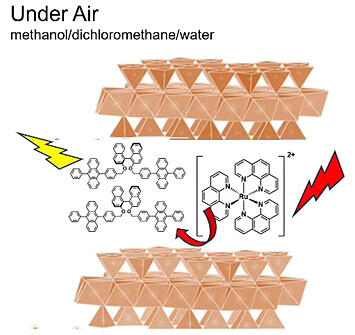A research group led by Professor Hisako Sato and Graduate Student Shohei Yamamoto from the Faculty of Science at Ehime University, in collaboration with the Toho University School of Medicine, the National Institute for Materials Science, and Nihon University College of Humanities and Sciences, announced that they have successfully constructed an optical up-conversion (UC) system in a clay colloid. Optical UC is an energy conversion process that causes light emission at wavelengths shorter than the incident light, and this phenomenon is expected to have a wide range of applications, such as increasing the efficiency of solar energy and in situ detection in biological systems. It is expected to be widely applied as a light energy source with low environmental loads. The results were published in the international journal Applied Clay Science on May 11.

Provided by Ehime University
Smectite clay minerals are characterized by the high density of cationic molecules adsorbed in ion exchange on or between layer surfaces and uniform orientation and regular arrangement of adsorbed molecules under the periodic structure of phyllosilicate tetrahedral sheets on the layer surface. Therefore, the research group explored the construction of a UC for light energy using these characteristics in this study. In the emission of light by a molecule photoexcited by incident light, energy loss normally occurs during the relaxation process up to light emission, resulting in emission at a longer wavelength with lower photon energy than that of the incident light. Triplet-triplet annihilation (TTA) is employed to overcome this problem.
The results of this study showed that the luminescence intensity of the Ru(II) complex ([Ru(phen)3]2+ (phen = 1,10-phenanthroline)) was quenched by oxygen in solution, but it was recovered in saponite. In synthetic saponite, luminescence intensity was quenched in the presence of acceptor DPA (9,10-diphenylanthracene), confirming the efficient light energy transfer from the donor Ru complex to DPA. UC via TTA generally requires a reaction system with an advanced molecular design, but it was realized in a colloidal clay system in this research. The use of clay minerals, which are abundant on the earth, has paved the way for chiral sensing (detection of optically active molecules) by achieving stereoselective UC as an effect of clay surfaces being restricted to two dimensions.
Sato said, "In our laboratory, we have continued our research into the '2D regular structure of clay surfaces and the function of metal complexes with matched structures' as a key focus. Furthermore, particular attention was paid to the application of light energy to conversion and aggregation systems. As an extension of this development, we realized a process that converts the wavelength of the incident light to a shorter wavelength with higher energy in a clay-based system. The use of clay minerals, which are abundant on the earth and harmless to the human body, for this purpose is a new proposal for the 'advancement of light energy with less environmental loads,' which is currently required. We look forward to working with our collaborators to make further progress toward practical applications."
Journal Information
Publication: Applied Clay Science
Title: Up-conversion of photon energy in colloidal clay systems
DOI: 10.1016/j.clay.2024.107397
This article has been translated by JST with permission from The Science News Ltd. (https://sci-news.co.jp/). Unauthorized reproduction of the article and photographs is prohibited.




